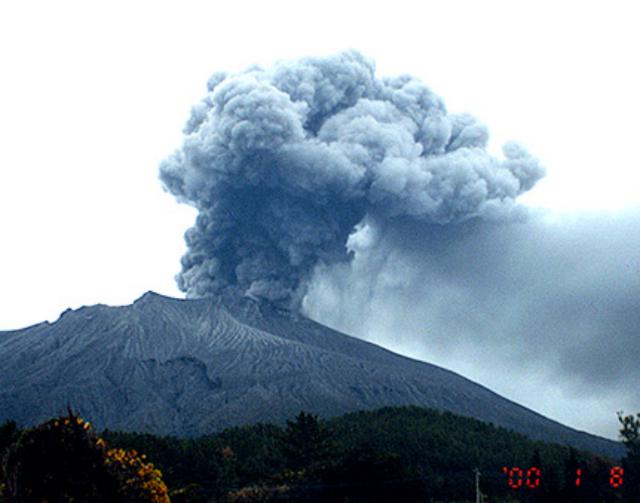Report on Aira (Japan) — February 2000
Bulletin of the Global Volcanism Network, vol. 25, no. 2 (February 2000)
Managing Editor: Richard Wunderman.
Aira (Japan) Frequent explosive eruptions continue from Minami-dake
Please cite this report as:
Global Volcanism Program, 2000. Report on Aira (Japan) (Wunderman, R., ed.). Bulletin of the Global Volcanism Network, 25:2. Smithsonian Institution. https://doi.org/10.5479/si.GVP.BGVN200002-282080
Aira
Japan
31.5772°N, 130.6589°E; summit elev. 1117 m
All times are local (unless otherwise noted)
The southern-most cone at Sakura-jima, Minami-dake, manifested increased eruptivity from late October to early November 1999. Following a lull in the second half of November, vigorous activity in December was marked by incandescent columns, large amounts of bomb ejections, and ballistics falling as far as 4 km from the crater.
High eruptive activity occurred in late October and early November 1999. On 31 October the JMA issued a Volcanic Advisory. In early November, 19 eruptions (including 18 explosions) occurred at Minami-dake before activity declined to lower levels later in the month. Activity increased again in early December with a few explosions each day and small numbers of ballistic clasts falling onto the upper slopes. On the afternoon of 10 December JMA issued another Volcanic Advisory. At 0555 this day, Sakura-jima issued a large amount of bombs. Incandescent columns as high as 100 m were accompanied 116 times by volcanic lightning. According to a JMA field inspection, ballistics were scattered 3-4 km away from the Minami-dake crater; the maximum size was 4 cm across. Incandescent columns rose as high as 300 m at 0554 on 24 December and were accompanied by volcanic lightning six times.
Daily numbers of eruptions ranged from 2 to 8 during early- to mid-December; eruptions were mostly explosive. The maximum amplitude of explosion earthquakes recorded at JMA observation point A, 4.6-km WNW of the crater, reached up to 28 µm; the largest value was caused by an explosion at 1301 on 12 December. The plume heights of December explosions ranged from 1,500 m to 2,000 m. Explosions took place on 23 consecutive days between 3 and 25 December. This is the longest record of daily explosions since JMA started observing Sakura-jima in 1955; the previous record was 21 days in 1960. Explosions began again late in the month, with six more on 31 December.
The total of 88 explosions during December 1999 was the second highest monthly count since 1955; the highest was 93 explosions in June 1974. According to the JMA, the total number of eruptions in 1999 was 386, including 237 explosions.
Frequent explosive eruptions continued in early January (figure 21). Explosions on 2 January sent an eruption column to 2,200 m above the crater rim and emitted abundant cinders, as well as bombs that fell midway down the flanks of the volcano. Nine explosive eruptions occurred on 5 January, one of which again ejected cinders and bombs as far as the middle flank of the volcano. The highest plumes in early January reached 2,200 m above the crater rim during explosions at 0821 on 5 January and at 0746 on 14 January. The maximum amplitude of explosion seismic signals at JMA observation point A (4.6 km WNW of the active crater) was 17 µm for the 0513 explosion on 14 January.
 |
Figure 21. Eruption at Sakura-jima at 0900 on 8 January 2000 from 3.5 km SW of the Minami-dake crater. Courtesy of Tatsuro Chiba. |
Geological Summary. The Aira caldera in the northern half of Kagoshima Bay contains the post-caldera Sakurajima volcano, one of Japan's most active. Eruption of the voluminous Ito pyroclastic flow accompanied formation of the 17 x 23 km caldera about 22,000 years ago. The smaller Wakamiko caldera was formed during the early Holocene in the NE corner of the caldera, along with several post-caldera cones. The construction of Sakurajima began about 13,000 years ago on the southern rim and built an island that was joined to the Osumi Peninsula during the major explosive and effusive eruption of 1914. Activity at the Kitadake summit cone ended about 4,850 years ago, after which eruptions took place at Minamidake. Frequent eruptions since the 8th century have deposited ash on the city of Kagoshima, located across Kagoshima Bay only 8 km from the summit. The largest recorded eruption took place during 1471-76.
Information Contacts: JMA-Fukuoka, Japan Meteorological Agency (JMA), 1-3-4 Ote-machi, Chiyoda-ku, Tokyo 100, Japan; Setsuya Nakada, Volcano Research Center, ERI, University of Tokyo, Yayoi 1-1-1, Bunkyo-ku, Tokyo 113, Japan (URL: http://www.eri.u-tokyo.ac.jp/VRC/index_E.html); Tatsuro Chiba, Nihon University, Japan (URL: http://www.nihon-u.ac.jp/en/).

